2015.5 Peugeot Boxer engine
[x] Cancel search: enginePage 5 of 276
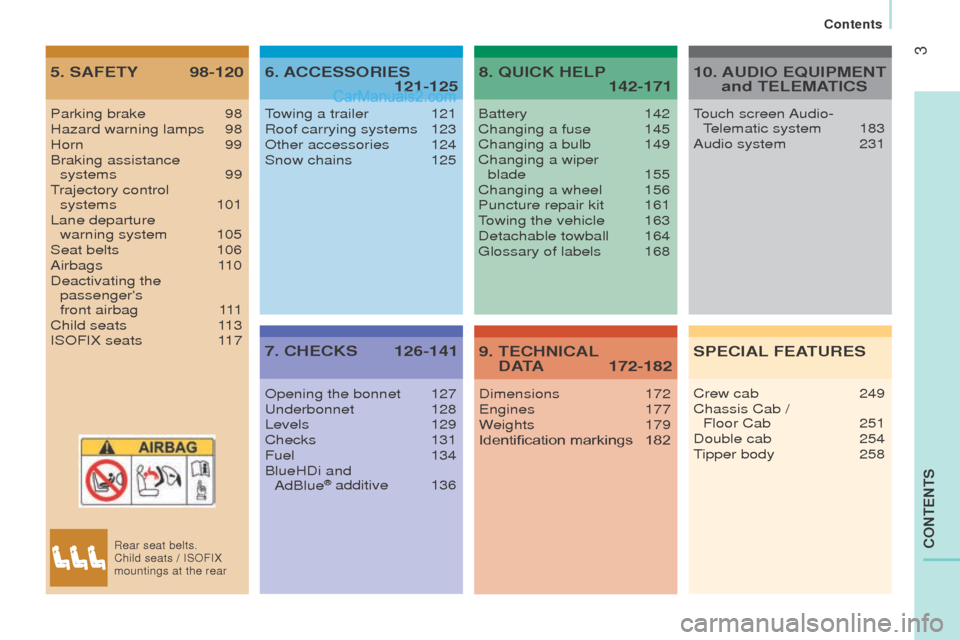
3
cont
Ent
S
5. SAFEtY 98-120 6. AccESSorIES 121-125
7.
cHEcKS 126-141 8.
QuIcK HELP
142-171
9.
tEcHnIcAL
dAtA 172-182
Parking brake 98
Hazard warning lamps 98
Horn 99
Braking assistance systems
99trajectory control systems 101
Lane departure warning system
105
Seat belts 106
Airbags 1
10
Deactivating the passenger's
front airbag
11
1
Child seats
113
ISOFIX seats 117
towing a trailer 121
Roof carrying systems 123
Other accessories 124
Snow chains 125
Opening the bonnet
127underbonnet 128
Levels 129
Checks 131
Fuel 134
BlueHDi and AdBlue
® additive 136 Battery
142
Changing a fuse 145
Changing a bulb 149
Changing a wiper blade
155
Changing a wheel 156
Puncture repair kit 161towing the vehicle 163
Detachable towball 164glossary of labels 168
Dimensions
172engines 177
W
eights
179
Identification markings 182
10. AudIo EQuIPMEnt
and tELEMAtIcS
SPE
cIAL
FEA
turES
touch screen Audio-telematic system 183
Audio system 231
Crew cab
249
Chassis Cab / Floor Cab
251
Double cab 254tipper body 258
Rear seat belts.
Child seats / ISOFIX
mountings at the rear
Contents
Page 12 of 276
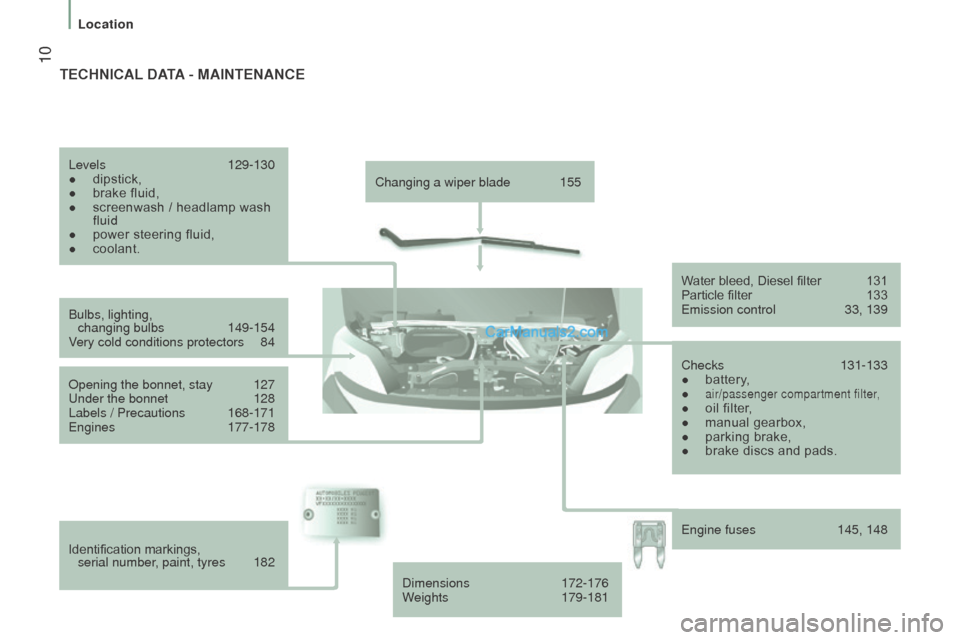
10
Changing a wiper blade 155
Bulbs, lighting, changing bulbs
149-154
Very cold conditions protectors 84
Opening the bonnet, stay
127under the bonnet 128
Labels / Precautions 168-171engines 177-178
Identification markings, serial
number
, paint, tyres
182
Levels
129-130
● dipstick,
● brake fluid,
● screenwash / headlamp wash
fluid
●
power steering fluid,
● coolant.
Water bleed, Diesel filter
131
Particle filter 133emission control 33, 139
Checks
131-133
● battery,
● air/passenger compartment filter,● oil filter,
● manual gearbox,
● parking brake,
● brake discs and pads.
tEcHnIcAL dAtA - MAIntEnAncE
Dimensions 172-176
Weights 179-181
engine fuses 145, 148
Location
Page 13 of 276
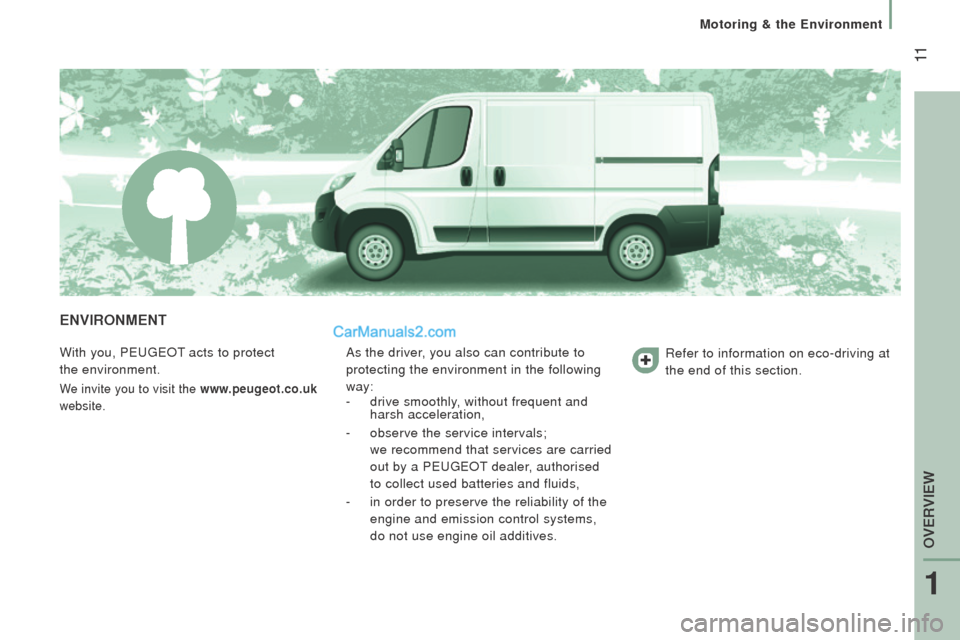
11
EnVIronMEnt
With you, PeugeOt acts to protect
the
environment.
We invite you to visit the www.peugeot.co.uk
website.
As the driver, you also can contribute to
protecting the environment in the following
way:
-
drive smoothly, without frequent and
harsh acceleration,
-
observe the service intervals;
we
recommend that services are carried
out by a P
eugeOt dealer, authorised
to collect used batteries and fluids,
-
in order to preserve the reliability of the
engine and emission control systems,
do not use engine oil additives. Refer to information on eco-driving at
the end of this section.
1
OVeRVIeW
Motoring & the environment
Page 14 of 276
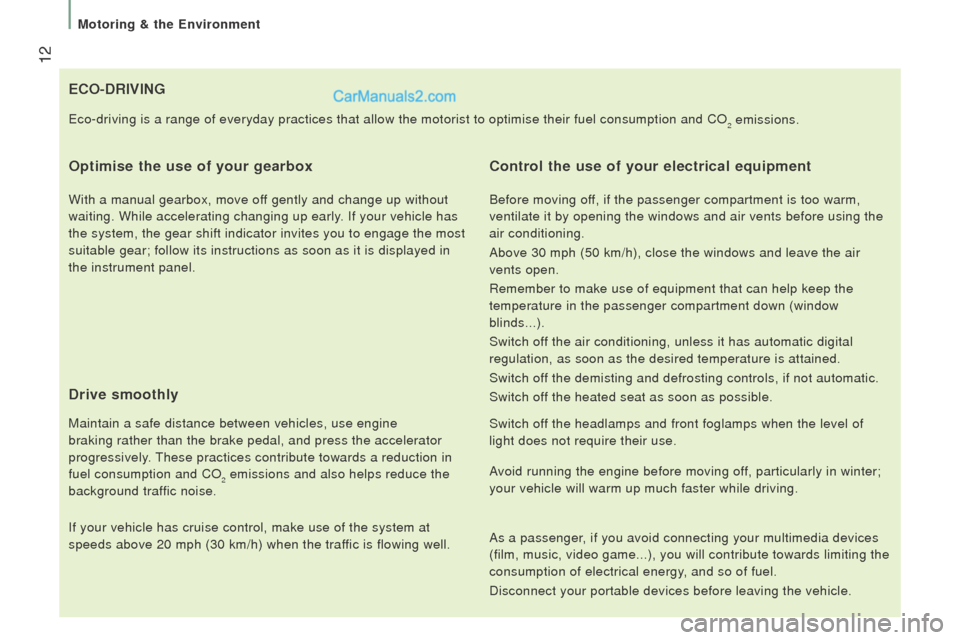
12
Eco-drIVInG
o
ptimise the use of your gearbox
With a manual gearbox, move off gently and change up without
waiting. While accelerating changing up early. If your vehicle has
the system, the gear shift indicator invites you to engage the most
suitable gear; follow its instructions as soon as it is displayed in
the instrument panel.
drive smoothly
Maintain a safe distance between vehicles, use engine
braking rather than the brake pedal, and press the accelerator
progressively.
these practices contribute towards a reduction in
fuel consumption and CO
2 emissions and also helps reduce the
background traffic noise.
If your vehicle has cruise control, make use of the system at
speeds above 20 mph (30 km/h) when the traffic is flowing well.
control the use of your electrical equipment
Before moving off, if the passenger compartment is too warm,
ventilate it by opening the windows and air vents before using the
air conditioning.
Above 30 mph (50 km/h), close the windows and leave the air
vents open.
Remember to make use of equipment that can help keep the
temperature in the passenger compartment down (window
blinds...).
Switch off the air conditioning, unless it has automatic digital
regulation, as soon as the desired temperature is attained.
Switch off the demisting and defrosting controls, if not automatic.
Switch off the heated seat as soon as possible.
Switch off the headlamps and front foglamps when the level of
light does not require their use.
eco-driving is a range of everyday practices that allow the motorist to o\
ptimise their fuel consumption and CO2 emissions.
Avoid running the engine before moving off, particularly in winter;
your vehicle will warm up much faster while driving.
As a passenger, if you avoid connecting your multimedia devices
(film, music, video game...), you will contribute towards limiting the\
consumption of electrical energy, and so of fuel.
Disconnect your portable devices before leaving the vehicle.
Motoring & the environment
Page 15 of 276
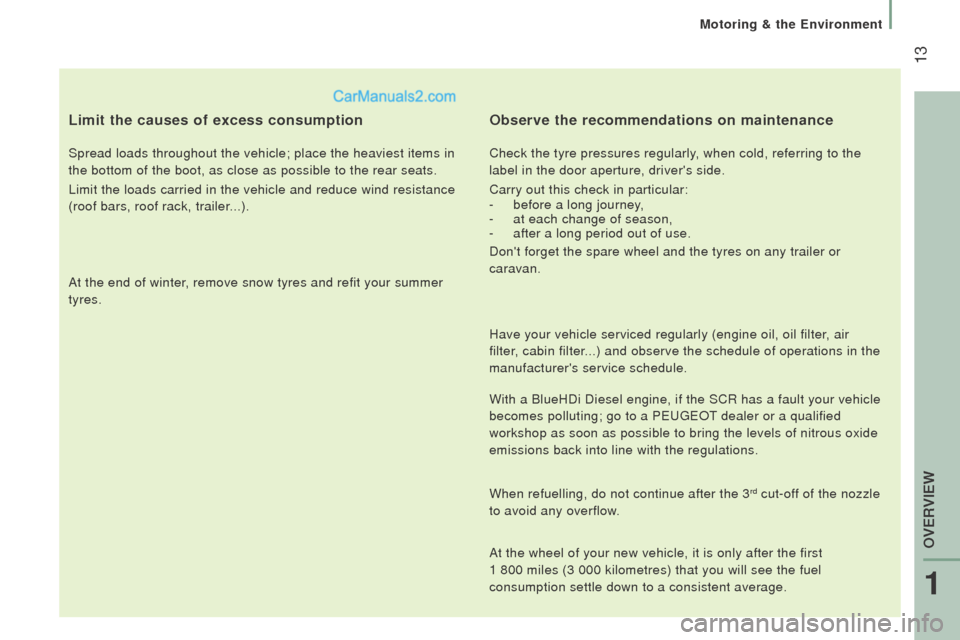
13
Limit the causes of excess consumption
Spread loads throughout the vehicle; place the heaviest items in
the bottom of the boot, as close as possible to the rear seats.
Limit the loads carried in the vehicle and reduce wind resistance
(roof bars, roof rack, trailer...).
At the end of winter, remove snow tyres and refit your summer
tyres.
observe the recommendations on maintenance
Check the tyre pressures regularly, when cold, referring to the
label in the door aperture, driver's side.
Carry out this check in particular:
-
before a long journey,
- at each change of season,
- after a long period out of use.
Don't forget the spare wheel and the tyres on any trailer or
caravan.
Have your vehicle serviced regularly (engine oil, oil filter
, air
filter, cabin filter...) and observe the schedule of operations in the
manufacturer's service schedule.
With a BlueHDi Diesel engine, if the SCR has a fault your vehicle
becomes polluting; go to a P
eugeOt dealer or a qualified
workshop as soon as possible to bring the levels of nitrous oxide
emissions back into line with the regulations.
When refuelling, do not continue after the 3
rd cut-off of the nozzle
to avoid any overflow.
At the wheel of your new vehicle, it is only after the first
1
800 miles (3 000 kilometres) that you will see the fuel
consumption settle down to a consistent average.
1
OVeRVIeW
Motoring & the environment
Page 18 of 276
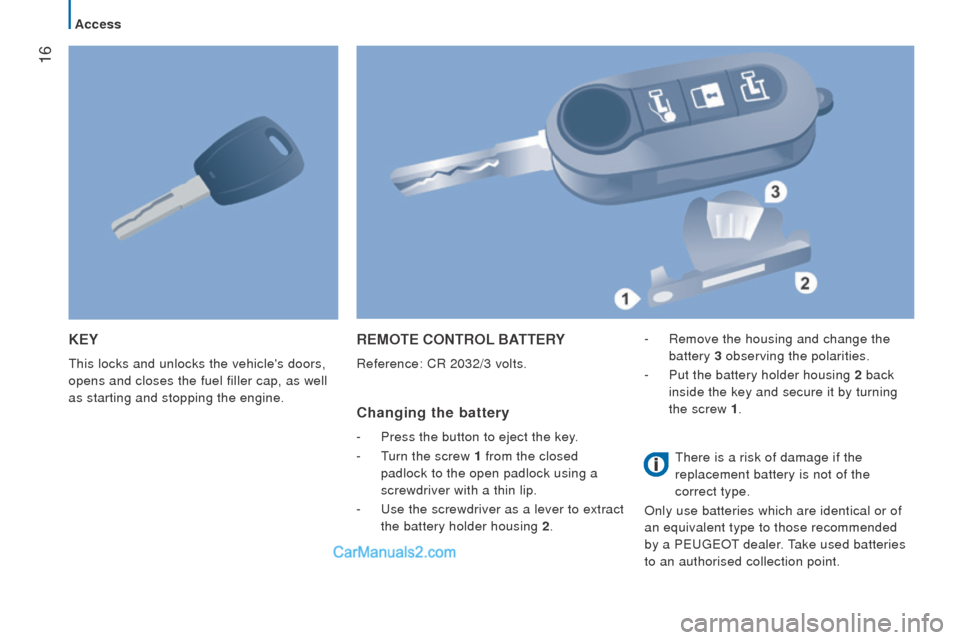
16
KEY
this locks and unlocks the vehicle's doors,
opens and closes the fuel filler cap, as well
as starting and stopping the engine.
rEMotE controL BAttErY
Reference: CR 2032/3 volts.
changing the battery
- Press the button to eject the key.
-
t
urn the screw 1 from the closed
padlock to the open padlock using a
screwdriver with a thin lip.
-
u
se the screwdriver as a lever to extract
the battery holder housing 2 .-
Remove the housing and change the
battery
3 observing the polarities.
-
Put the battery holder housing 2 back
inside the key and secure it by turning
the screw 1 .
there is a risk of damage if the
replacement battery is not of the
correct type.
Only use batteries which are identical or of
an equivalent type to those recommended
by a P
eugeOt dealer. take used batteries
to an authorised collection point.
Access
Page 20 of 276

18ELEctronIc IMMoBILISEr
All of the keys contain an electronic
immobiliser device.
this device locks the engine supply system.
It is activated automatically when the key is
removed from the ignition. Operating the remote control, even when it
is in your pocket, may result in involuntary
unlocking of the doors.
the simultaneous use of other high
frequency equipment (mobile telephones,
domestic alarms…), may interfere with the
operation of the remote control temporarily.
the remote control does not operate while
the key is in the ignition, even if the ignition
is off, except for reinitialisation.
Good practice
Make a careful note of the key number. If the
keys are are lost, it will be easier for your
P
eugeOt dealer to help if you can supply
this number and the confidential card.
Do not make any modifications to the
electronic immobiliser system.
this warning lamp is switched of
f
after the ignition is switched on
and the key has been recognised,
the engine can be started.
If the key is not recognised, the engine
cannot be started.
use another key and
have the faulty key checked by a P
eugeOt
dealer. After the ignition is switched on, a dialogue
is established between the key and the
electronic immobiliser system.
conFIdEntIAL cArd
this is given to you on delivery of your
vehicle with the duplicate keys.
It contains the identification code necessary
for any work carried out by a P
eugeOt
dealer on the electronic immobiliser system.
this code is hidden by a film, which should
be removed only if necessary.
Keep your card in a safe place, never inside
the vehicle.
When undertaking a long trip or journey,
however, it is advisable to take it with you
along with your personal papers.
When purchasing a second-hand vehicle:
-
ensure that you are given the
confidential card,
-
have the keys memorised by a
P
eugeOt dealer to ensure that the
keys in your possession are the only
ones which can start the vehicle.
Driving with the doors locked may
make access to the passenger
compartment by the emergency services
more difficult in an emergency.
As a safety precaution (with children on
board), remove the key from the ignition
when leaving the vehicle, even for a short
time.
Access
Page 21 of 276
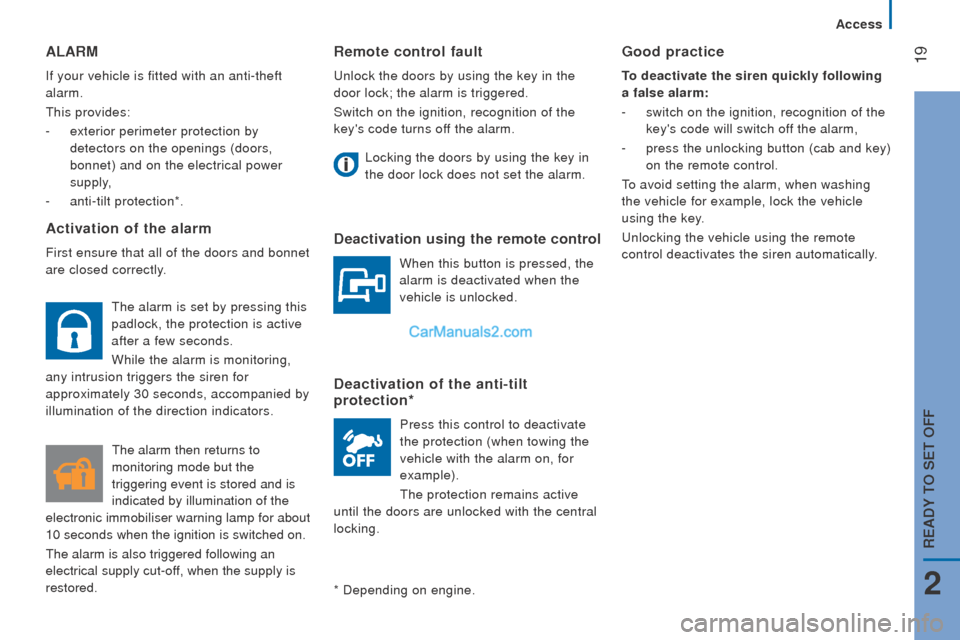
19remote control fault
unlock the doors by using the key in the
door lock; the alarm is triggered.
Switch on the ignition, recognition of the
key's code turns of
f the alarm.
Locking the doors by using the key in
the door lock does not set the alarm.
deactivation using the remote control
When this button is pressed, the
alarm is deactivated when the
vehicle is unlocked.
deactivation of the anti-tilt
protection*
Press this control to deactivate
the protection (when towing the
vehicle with the alarm on, for
example).
the protection remains active
until the doors are unlocked with the central
locking.
ALArM
If your vehicle is fitted with an anti-theft
alarm.
this provides:
-
exterior perimeter protection by
detectors on the openings (doors,
bonnet) and on the electrical power
supply,
-
anti-tilt protection*.
Activation of the alarm
First ensure that all of the doors and bonnet
are closed correctly.
*
Depending on engine.
Good practice
to deactivate the siren quickly following
a false alarm:
-
switch on the ignition, recognition of the
key's code will switch of
f the alarm,
-
press the unlocking button (cab and key)
on the remote control.
to avoid setting the alarm, when washing
the vehicle for example, lock the vehicle
using the key.
unlocking the vehicle using the remote
control deactivates the siren automatically.
the alarm is set by pressing this
padlock, the protection is active
after a few seconds.
While the alarm is monitoring,
any intrusion triggers the siren for
approximately 30 seconds, accompanied by
illumination of the direction indicators.
the alarm then returns to
monitoring mode but the
triggering event is stored and is
indicated by illumination of the
electronic immobiliser warning lamp for about
10
seconds when the ignition is switched on.
the alarm is also triggered following an
electrical supply cut-off, when the supply is
restored.
2
Access
rEAdY to SEt oFF